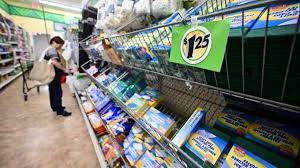
Economists and policymakers are bracing for a long and rocky road back to the US Federal Reserve’s target of 2 per cent inflation, even as early signs of relief emerge following the worst shock in decades.
Recent economic data suggests price pressures are finally beginning to ease, with the consumer price index last week showing the relentless rise in costs for some goods and services is levelling off or is on the verge of doing so.
But optimism has collided with lingering concern about how quickly “core” inflation — which strips out volatile food and energy prices — will actually decline from here. Over the past two years, hopes have been raised by encouraging data only for inflation to continue to rise.
“It is not only going to be a bumpy road, but what we worry about are the sticking points because [those] make it all the much harder to derail what could be more entrenched inflation,” said Diane Swonk, chief economist at KPMG.
Laurence Ball at Johns Hopkins University added: “I’m very cognisant, as people are, that you can get head-faked by a couple months of data.”
Keeping inflation-fighters on guard is the fact that the sources of higher prices at this stage stem from a wide range of services, from child care to haircuts, which tend to require more effort on the Fed’s part to root out.
As the economy recovered from the Covid-19 shock, supply-chain disruptions coupled with lockdowns — which limited how people could spend savings amassed owing to generous federal aid — to produce a historic boom in prices for everyday items such as washing machines and furniture. At one point, the price of used cars was increasing at an annual pace of roughly 40 per cent as shortages intensified, accounting for more than a fifth of overall inflation.
But as initial Covid fears ebbed and restaurants, movie theatres and other venues reopened, services-related inflation started to climb. Housing costs also boomed. Americans, bolstered by a red-hot labour market and better wages, were willing to stomach higher prices that companies began to charge to cover their own swelling expenses, accelerating an inflation surge that has since prompted forceful action from the US central bank.
In the past 15 months, the Fed has raised its benchmark rate over 5 percentage points, the fastest increase in decades as it has sought to damp demand. Officials are now contemplating whether they have done enough or if they need to squeeze the economy further to ensure inflation — as measured by the core personal consumption expenditures price index — returns to the Fed’s 2 per cent target. As of March, it was running at an annual pace of 4.6 per cent.
Following last week’s data, Omair Sharif, president of forecasting group Inflation Insights, said that “most of the pieces are in place” for core inflation to gradually ease from here. But he warned that the Fed’s target will remain elusive for some time.
“It’s really hard to see core inflation coming down to anything that’s approaching 2 per cent by the end of this year,” he said. “We’ll be fortunate to be about double that.”
Among the positive developments in the latest CPI report was mounting evidence that housing inflation was beginning to ease, reflecting last year’s sharp drop in rents and home prices that experts have been waiting to show up in the data. Also, a closely watched metric of underlying inflation — so-called “core services ex-housing” — decelerated to its slowest monthly pace since July 2022.
Sharif warned that the gauge can be highly volatile and disproportionately reflect travel-related expenses. But Jay Powell, the Fed chair, said last year that core services once housing is stripped out “may be the most important category for understanding the future evolution of core inflation” given it captures wage-related dynamics.
Previous bouts of high inflation provide some additional comfort. Alan Detmeister, a former Fed researcher now at UBS, studied inflation surges stretching back decades and concluded that the “best single inflation analogy is likely 1947” rather than the 1970s and 1980s, which became notorious for entrenched inflation.
In the post-second world war period, inflation — which, like today, was driven in part by pent-up savings, a sharp run-up in government spending, and an abrupt shift in consumer demand towards goods — declined gradually over time without a sharp rise in interest rates. Detmeister said that suggests the Fed need not further raise its benchmark rate, even though it could be at least a year before the Fed’s target is achieved.
Most economists polled by Bloomberg forecast it could take until 2025. That is roughly in line with the timeline most Fed officials projected, as of estimates published in March. They also maintain there will be no rate cuts until 2024, reflecting their view that the decline in inflation they need to see to support that would not have transpired before then.
“There is just tremendous uncertainty and on the inflation front, a real lack of confidence because you feel like the models that we thought we knew and worked well for quite a while in a period of very low inflation volatility just haven’t worked all that well,” said Bill English, former director of the Fed’s division of monetary affairs.
“What the Fed has emphasised is that they really do want to see inflation marching down before they conclude that they’re in a good place,” added English, who is now at Yale University.
“Forecasts of inflation coming down aren’t going to cut it.”


